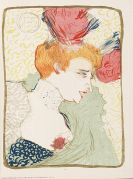
Ferdinand Victor Eugène Delacroix
1798 Paris
1863 Paris
Ferdinand Victor Eugène Delacroix was born in St-Maurice-Charenton near Paris on April 26, 1798 and is considered one of the most significant artists of French Romanticism.
The son of well-to-do parents, he moved with his mother from Bordeaux to Paris after the death of his father, a diplomat in Holland. In 1815, Eugène Delacroix began an apprenticeship in the studio of Pierre Narcisse Guérin. Copying the old masters in the Louvre belonged to the core practices of artistic education.
After the loss of the family fortune, his friend Jean Louis Théodore Géricault helped him get a public commission in 1821, an altarpiece for the convent of the Dames du Sacré-Coeur in Nantes (today the Cathedral of Ajaccio).
Already one year later, in 1822, he received high artistic praise for the painting "Dante and Virgil in Hell" (now in Paris, Musée National du Louvre). With this painting he also tread on completely new ground with the choice of theme.
In 1824, the French state – despite disparaging criticism – acquired the work "Masssacre of Chios" (now in Paris, Musée National du Louvre), which was presented in the Paris Public Salon.
In 1825, Eugène Delacroix took a trip to London. There he got to know numerous English artists and men of letters and also studied their work. He produced a series of lithographs, among them 19 pages for Goethe’s "Faust", for which Goethe himself expressed his full admiration. He also created 16 illustrations for "Hamlet". The inspirations from his stay in England became visible in the artist’s works after his return to Paris.
The tones became brighter and more expressive, and his figurative works from 1827, exhibited in the Salon in Paris, made him a celebrated forerunner of Romanticism.
At the same time he created illustrations for the magazine "Le Miroir", also influenced by his literary friends Victor Hugo, Honoré de Balzac, Alexandre Dumas the Elder and Stendhal. Beginning in 1830, Eugène Delacroix, inspired by the July Revolution, worked on studies for the painting "Freedom Leads the People onto the Barricades" (now in Paris, Musée National du Louvre).
This painting was bought in 1831 by the State under King Louis-Philippe, but it was given back to the artist after the regime change in 1844.
In 1832, Eugène Delacroix, at his own expense, accompanied a delegation to Morocco. For over a half year, he captured his North African impressions in numerous sketches and watercolors; these served afterwards as studies for later paintings. He was successful in translating his fascination for oriental colors and scenes full of vitality and passion, sensuously and expressively, into paintings.
In "The Women of Algiers" from 1834 (today in Paris, Musée National du Louvre), his color differentiation, which was becoming more and more clear, displays itself. His productivity was incomparable.
Besides numerous paintings, at the same time he produced large-format wall decorations, such as for example that of the cupola in the Palais Bourbon 1847; in 1845-47, as a government commission, the ceiling and wall paintings in the library of the Palais du Luxembourg; and in 1850–51 he worked out the decor of the Galerie d`Apollon in the Louvre.
The temperamental artist, who worked tirelessly, spent the last years of his life mostly in seclusion. In his work, the classical ideal of perfection in figures and scenes is united with the romantic ideal of the infinite in the palette of 19th-century art.
On August 13, 1863, Eugène Delacroix died in Paris.

Would you like to sell a work by Ferdinand Victor Eugène Delacroix?
Infos for seller






